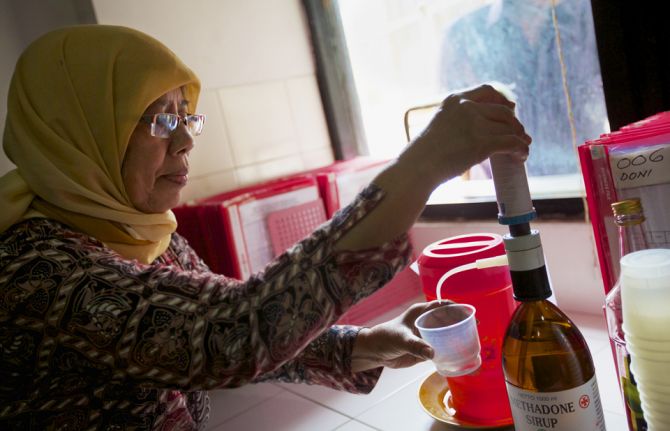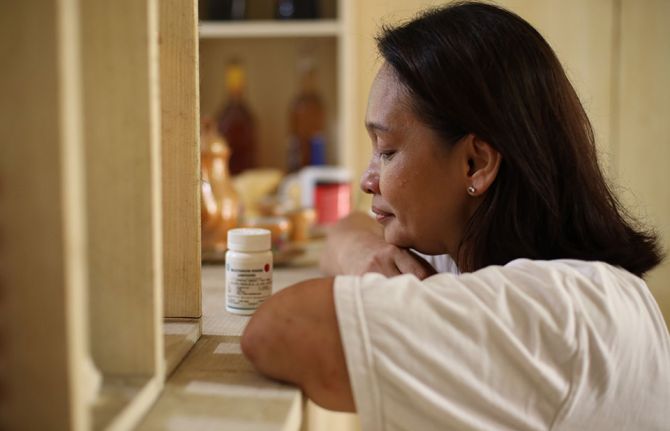

Feature Story
Ending AIDS by 2030 requires investment in harm reduction for people who inject drugs
10 October 2016
10 October 2016 10 October 2016To end the AIDS epidemic by 2030, the global response to HIV must leave no one behind, including people who inject drugs. It requires drug policies and HIV-related prevention, treatment, care and support services that meet both the human rights and the health needs of people who inject drugs.
Estimates show that worldwide there are approximately 12 million people who inject drugs, 1.6 million (14%) of whom are living with HIV and 6 million (50%) of whom are living with hepatitis C. HIV prevalence among women who inject drugs is often greater than among their male peers. UNAIDS estimates that 140 000 people who inject drugs were newly infected with HIV globally in 2014 and there has been no decline in the annual number of new HIV infections among people who inject drugs between 2010 and 2014.
The UNAIDS report Do no harm: health, human rights and people who use drugs shows that having laws and policies that do no harm to people who use drugs and increasing investments in harm reduction programmes and services results in a decrease in new HIV infections and improved health outcomes and delivers broader social benefits.
The United Nations Office on Drugs and Crime, the World Health Organization (WHO) and UNAIDS recommend using these programmes and services as a comprehensive package, as outlined in the WHO’s consolidated guidelines on HIV prevention, diagnosis, treatment and care for key populations.
Harm reduction works
The evidence is overwhelming—harm reduction works. Opioid substitution therapy has been associated with a 54% reduction in the risk of HIV infection among people who inject drugs and has been shown to decrease the risk of hepatitis C infection, to increase adherence to antiretroviral therapy for HIV, to lower out-of-pocket health expenditures and to reduce opioid overdose risk by almost 90%.
In Australia, 10 years of needle–syringe programming has reduced the number of cases of HIV by up to 70% and decreased the number of cases of hepatitis C by up to 43%.
The evidence is also clear that laws and policies that hinder access to health services for people who use drugs do not work. For example, police surveillance of health-care and harm reduction service providers discourages people who inject drugs from accessing those services.
“Putting the AIDS response on the Fast-Track requires promoting the rights of people who use drugs to access high-quality, evidence-informed HIV harm reduction services and removing barriers to accessing these services,” says Aldo Lale-Demoz, the Deputy Executive Director of the United Nations Office on Drugs and Crime.
Having laws that offer alternatives to prosecution and imprisonment for drug use and possession of drugs for personal use reduces the harmful health effects associated with drug use and does not result in an increased use of drugs.
Community-led harm reduction programmes can reach people who inject drugs with needle–syringe exchange and other services and provide linkages to testing, treatment and care for people living with HIV. In Pakistan, for example, the Nai Zindagi Trust, a peer-led outreach programme, has been in operation for 25 years and reaches about 13 000 street-based people who inject drugs through more than 600 trained peer educators.
The case for investment
Despite the large body of evidence, however, only 80 of the 158 countries in which injecting drug use has been documented have at least one location offering opioid substitution therapy, and only 43 countries have programmes in prisons. Needle–syringe programmes are available in only 90 countries and only 12 countries provide the recommended threshold of 200 sterile needles per person who injects drugs per year.
The combination of unavailability of harm reduction services and inadequate coverage where available puts progress in the response to HIV at risk. It also denies life-saving health services to millions of people who inject drugs.
“When it comes to people who use drugs, evidence has been necessary, but insufficient, to catalyse the needed commitments from governments and donors. Harm reduction is one HIV prevention technology that clearly works, that people in need want and that costs little. Disinvestment makes neither scientific nor moral sense,” says Daniel Wolfe, of the Open Society Foundations.
Current investments in harm reduction services are insufficient. And maintenance of current levels is not enough to end the AIDS epidemic by 2030 and meet the commitments made in the 2016 Political Declaration on Ending AIDS. The majority of people who inject drugs live in middle- and upper-income countries, yet current donor policies are transitioning international aid out of middle-income countries, putting in danger the continuation of existing services and risking the reversal of successes to date.
It is hoped that affected country governments, the successful replenishment of the Global Fund to Fight AIDS, Tuberculosis and Malaria, and new initiatives, such as the Key Populations Investment Fund, will contribute significantly to scaling-up evidence-informed programming for people who inject drugs.
“People who inject drugs are among those who have been left furthest behind by the global response to HIV,” says Mauro Guarinieri of the Global Fund, “We need to recognize that the level of criminalization, discrimination and violence that people who use drugs face, can only result in driving risk-taking behaviours, excluding them from the social and health support systems they need. We must move toward treating everyone, including people who use drugs, as fellow human beings.”



